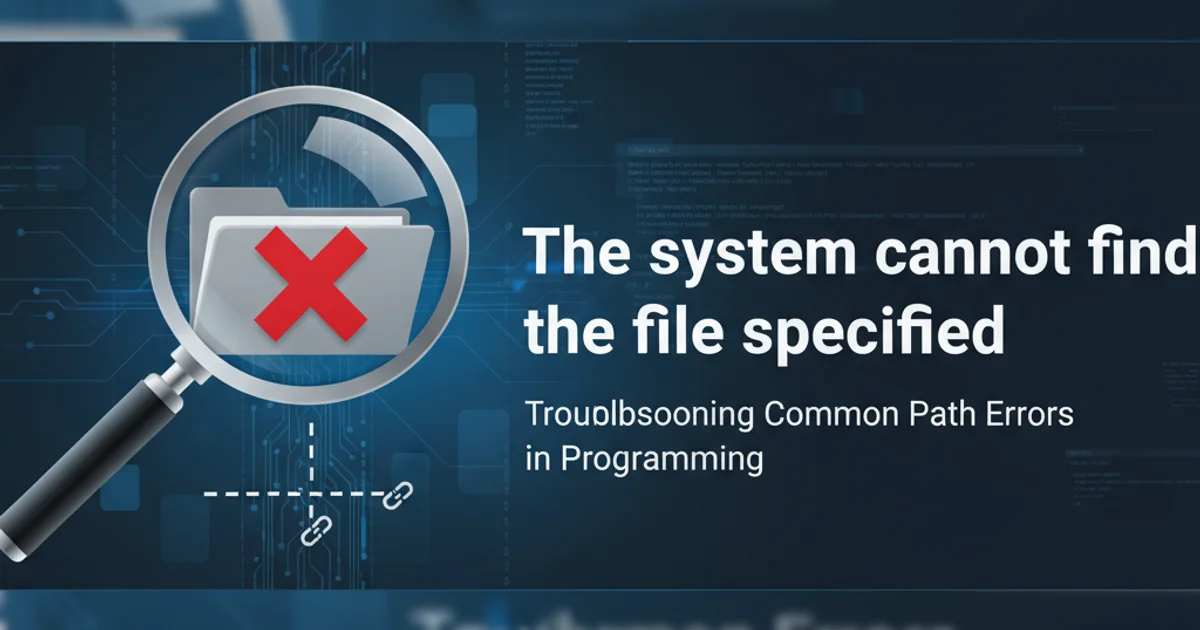"The system cannot find the file specified"
Categories:
Troubleshooting 'The system cannot find the file specified' in ASP.NET Membership

This article provides a comprehensive guide to diagnosing and resolving the common 'The system cannot find the file specified' error when working with ASP.NET Membership, particularly concerning database and configuration issues.
The error message "The system cannot find the file specified" is a generic but frequently encountered issue in various computing contexts. When it appears within an ASP.NET application, especially in relation to Membership providers, it often points to problems with database connectivity, file paths for database files, or incorrect configuration settings. This article will delve into the common causes and provide systematic steps to troubleshoot and resolve this error, ensuring your ASP.NET Membership functionality operates smoothly.
Understanding the Error Context
In the context of ASP.NET Membership, this error typically arises when the application attempts to access a resource that it expects to be present but cannot locate. This resource is most commonly a database file (like an .mdf or .sdf file for SQL Server Express/Compact) or a related log file, or it could be an issue with the database server itself not being accessible. The Membership provider needs a functional data store to manage users, roles, and profiles. If it can't find or connect to this store, this error is a common symptom.
flowchart TD
A[ASP.NET Application] --> B{Membership Provider Initialization}
B --> C{Read web.config}
C --> D{Locate Connection String}
D --> E{Attempt Database Connection}
E -- "File Not Found" --> F["Error: 'The system cannot find the file specified'"]
E -- "Connection Successful" --> G[Membership Operations]
F --> H{Troubleshooting Steps}Flowchart of ASP.NET Membership Initialization and Error Point
Common Causes and Solutions
Several factors can lead to this error. Identifying the exact cause requires a systematic approach, starting from your application's configuration and moving towards the underlying database setup.
web.config file first. Many ASP.NET Membership issues stem from incorrect or outdated connection strings and provider configurations.1. Incorrect Connection String or Database Path
This is arguably the most frequent cause. The connection string in your web.config file tells your application how to connect to the database. If the path to a local database file (.mdf, .sdf) is wrong, or if the server name for a remote database is incorrect, the system won't be able to find the specified 'file' (which could be the database itself or a component it relies on).
<connectionStrings>
<add name="ApplicationServices"
connectionString="Data Source=.\SQLEXPRESS;AttachDbFilename=|DataDirectory|\aspnetdb.mdf;Integrated Security=True;User Instance=True"
providerName="System.Data.SqlClient" />
</connectionStrings>
Example of a typical ASP.NET Membership connection string in web.config
1. Verify web.config Connection String
Open your web.config file and locate the <connectionStrings> section. Ensure the connectionString attribute for your Membership provider (often named ApplicationServices or similar) is correct. Pay close attention to AttachDbFilename if you're using SQL Server Express/Compact. The |DataDirectory| placeholder usually resolves to the App_Data folder in your web application.
2. Check Database File Existence
If using AttachDbFilename, navigate to your App_Data folder (or the path specified) and confirm that the .mdf (and .ldf) or .sdf file actually exists at that location. If it's missing, you might need to create it (e.g., by running aspnet_regsql.exe or deploying your database).
3. Validate SQL Server Instance Name
If connecting to a SQL Server instance (e.g., Data Source=.\SQLEXPRESS), ensure the instance name is correct and the SQL Server service is running. You can check this via SQL Server Configuration Manager or Services.msc.
2. Permissions Issues
Even if the file exists and the path is correct, the ASP.NET worker process might not have the necessary permissions to access the database file or the directory it resides in. This is particularly common with AttachDbFilename scenarios.
1. Grant Folder Permissions
Locate the App_Data folder (or the folder containing your .mdf or .sdf file). Right-click the folder, go to 'Properties' -> 'Security' tab. Add the IIS user account (e.g., IIS_IUSRS, NETWORK SERVICE, or the specific Application Pool identity) and grant it 'Read', 'Write', and 'Modify' permissions.
2. Check SQL Server Permissions
If connecting to a full SQL Server instance, ensure the user account specified in your connection string (or the integrated security account) has appropriate permissions to the database (e.g., db_owner or specific roles for Membership).
3. SQL Server Express/Compact Specific Issues
When using SQL Server Express or Compact Edition, additional considerations come into play. SQL Server Express uses 'User Instances' by default, which can sometimes lead to issues if not configured correctly or if the instance fails to start.
User Instance=True with SQL Server Express is generally not recommended for production environments due to potential permission and management complexities. Consider migrating to a full SQL Server instance or a dedicated database server.1. Verify SQL Server Express Installation
Ensure SQL Server Express is properly installed and its services are running. Sometimes, a corrupted installation can prevent it from creating or attaching database files.
2. Check for SQL Server Express User Instance Problems
If User Instance=True is in your connection string, the error might indicate that the user instance failed to start. Check the Windows Event Viewer for SQL Server-related errors. You might try removing User Instance=True and AttachDbFilename and instead connect to an existing database on the SQL Express instance.
4. Missing or Corrupt Database
The database file itself might be missing or corrupted. This can happen during deployment, if files are accidentally deleted, or if there's a disk error.
1. Re-create the Membership Database
If you suspect the database is missing or corrupt, you can use the aspnet_regsql.exe tool to create a new, empty ASP.NET Membership database. This tool is typically found in C:\Windows\Microsoft.NET\Framework\<version> or C:\Windows\Microsoft.NET\Framework64\<version>.
2. Deploy Database Files Correctly
When deploying your application, ensure that the .mdf and .ldf (or .sdf) files are included in the deployment package and placed in the correct directory on the server (e.g., App_Data).
aspnet_regsql.exe -S .\SQLEXPRESS -E -A all -d aspnetdb
Command to create an ASP.NET Membership database using aspnet_regsql.exe for SQL Server Express.